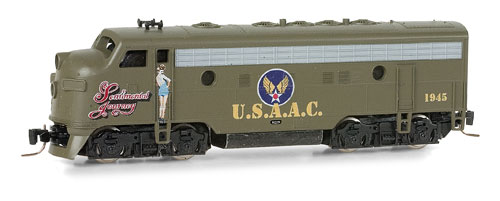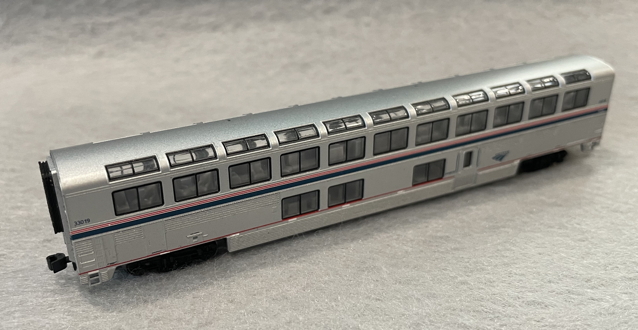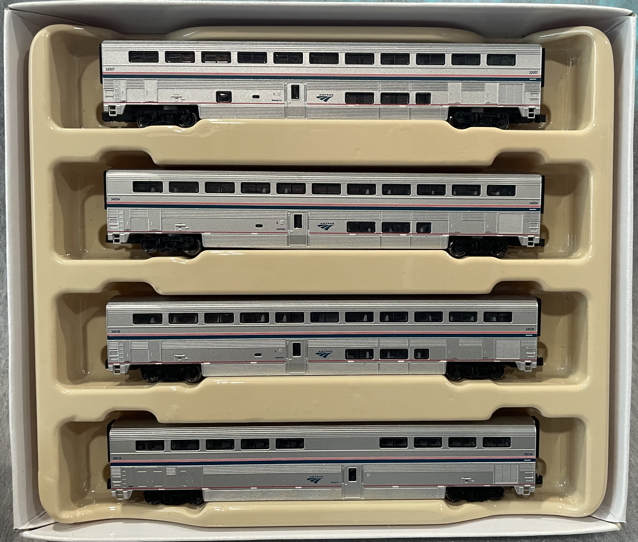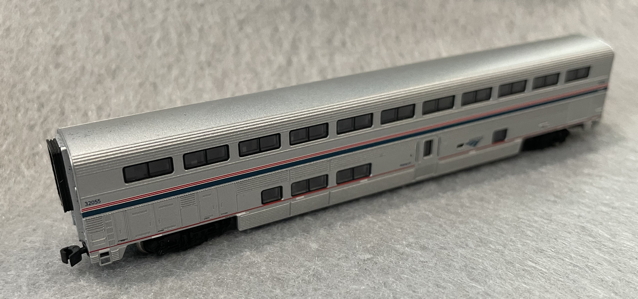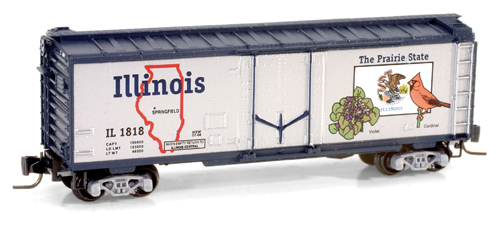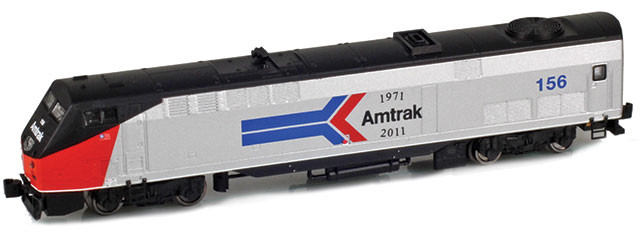Prototype History: The F7 was the fourth model in GM-EMD's successful line of F unit locomotives, and by far the best-selling cab unit of all time. In fact, more F7's were built than all other F units combined. It succeeded the F3 model in GM-EMD's F unit sequence, and was replaced in turn by the F9. Final assembly was at GM-EMD's La Grange, Illinois, plant or GMD's London, Ontario, facility.
The F7 differed from the F3 primarily in internal equipment (mostly electrical) and some external features. Its continuous tractive effort rating was 20% higher (e.g. 40,000 lb (18,000 kg) for an F7 with 65 mph (105 km/h) gearing, compared to 32,500 lb (14,700 kg) for an F3 with the same gearing.
A total of 2,366 cab-equipped lead A units and 1,483 cabless-booster or B units were built. (Note: the B unit is often referred to as an "F7B", whereas the A unit is simply an "F7".)
Many F7s remained in service for decades, as railroads found them economical to operate and maintain. However, the locomotive was not very popular with yard crews who operated them in switching service because they were difficult to mount and dismount, and it was also nearly impossible for the engineer to see hand signals from a ground crew without leaning way outside the window. As most of these engines were bought and operated before two-way radio became standard on most American railroads, this was a major point of contention. In later years, with the advent of the "road switchers" such as the EMD GP7, F units were primarily used in "through freight" and "unit train" service where there was very little or no switching to be done on line of road.
From Wikipedia
Read more on American-Rails.com
The F7 differed from the F3 primarily in internal equipment (mostly electrical) and some external features. Its continuous tractive effort rating was 20% higher (e.g. 40,000 lb (18,000 kg) for an F7 with 65 mph (105 km/h) gearing, compared to 32,500 lb (14,700 kg) for an F3 with the same gearing.
A total of 2,366 cab-equipped lead A units and 1,483 cabless-booster or B units were built. (Note: the B unit is often referred to as an "F7B", whereas the A unit is simply an "F7".)
Many F7s remained in service for decades, as railroads found them economical to operate and maintain. However, the locomotive was not very popular with yard crews who operated them in switching service because they were difficult to mount and dismount, and it was also nearly impossible for the engineer to see hand signals from a ground crew without leaning way outside the window. As most of these engines were bought and operated before two-way radio became standard on most American railroads, this was a major point of contention. In later years, with the advent of the "road switchers" such as the EMD GP7, F units were primarily used in "through freight" and "unit train" service where there was very little or no switching to be done on line of road.
From Wikipedia
Read more on American-Rails.com
Road Name History: The United States Army Air Corps (USAAC) was the military aviation arm of the United States of America between 1926 and 1941. The statutory administrative forerunner of the United States Air Force, it was renamed from the earlier United States Army Air Service on 2 July 1926 and part of the larger United States Army. The Air Corps was the immediate predecessor of the United States Army Air Forces (USAAF), established on 20 June 1941. Although discontinued as an administrative echelon during World War II, the Air Corps (AC) remained as one of the combat arms of the Army until 1947, when it was legally abolished by legislation establishing the Department of the Air Force.
The Air Corps was renamed by the United States Congress largely as a compromise between the advocates of a separate air arm and those of the traditionalist Army high command who viewed the aviation arm as an auxiliary branch to support the ground forces. Although its members worked to promote the concept of air power and an autonomous air force between the years between the world wars, its primary purpose by Army policy remained support of ground forces rather than independent operations.
On 1 March 1935, still struggling with the issue of a separate air arm, the Army activated the General Headquarters Air Force for centralized control of aviation combat units within the continental United States, separate from but coordinate with the Air Corps. The separation of the Air Corps from control of its combat units caused problems of unity of command that became more acute as the Air Corps enlarged in preparation for World War II. This was resolved by the creation of the Army Air Forces (AAF), making both organizations subordinate to the new higher echelon.
The Air Corps ceased to have an administrative structure after 9 March 1942, but as "the permanent statutory organization of the air arm, and the principal component of the Army Air Forces," the overwhelming majority of personnel assigned to the AAF were members of the Air Corps.
The Air Corps was renamed by the United States Congress largely as a compromise between the advocates of a separate air arm and those of the traditionalist Army high command who viewed the aviation arm as an auxiliary branch to support the ground forces. Although its members worked to promote the concept of air power and an autonomous air force between the years between the world wars, its primary purpose by Army policy remained support of ground forces rather than independent operations.
On 1 March 1935, still struggling with the issue of a separate air arm, the Army activated the General Headquarters Air Force for centralized control of aviation combat units within the continental United States, separate from but coordinate with the Air Corps. The separation of the Air Corps from control of its combat units caused problems of unity of command that became more acute as the Air Corps enlarged in preparation for World War II. This was resolved by the creation of the Army Air Forces (AAF), making both organizations subordinate to the new higher echelon.
The Air Corps ceased to have an administrative structure after 9 March 1942, but as "the permanent statutory organization of the air arm, and the principal component of the Army Air Forces," the overwhelming majority of personnel assigned to the AAF were members of the Air Corps.
Brand/Importer Information:  Micro-Trains Line split off from Kadee Quality Products in 1990. Kadee Quality Products originally got involved in N-Scale by producing a scaled-down version of their successful HO Magne-Matic knuckle coupler system. This coupler was superior to the ubiquitous 'Rapido' style coupler due to two primary factors: superior realistic appearance and the ability to automatically uncouple when stopped over a magnet embedded in a section of track. The success of these couplers in N-Scale quickly translated to the production of trucks, wheels and in 1972 a release of ready-to-run box cars.
Micro-Trains Line split off from Kadee Quality Products in 1990. Kadee Quality Products originally got involved in N-Scale by producing a scaled-down version of their successful HO Magne-Matic knuckle coupler system. This coupler was superior to the ubiquitous 'Rapido' style coupler due to two primary factors: superior realistic appearance and the ability to automatically uncouple when stopped over a magnet embedded in a section of track. The success of these couplers in N-Scale quickly translated to the production of trucks, wheels and in 1972 a release of ready-to-run box cars.
Micro-Trains Line Co. split off from Kadee in 1990 to form a completely independent company. For this reason, products from this company can appear with labels from both enterprises. Due to the nature of production idiosyncrasies and various random factors, the rolling stock from Micro-Trains can have all sorts of interesting variations in both their packaging as well as the products themselves. When acquiring an MTL product it is very important to understand these important production variations that can greatly enhance (or decrease) the value of your purchase.

Micro-Trains Line Co. split off from Kadee in 1990 to form a completely independent company. For this reason, products from this company can appear with labels from both enterprises. Due to the nature of production idiosyncrasies and various random factors, the rolling stock from Micro-Trains can have all sorts of interesting variations in both their packaging as well as the products themselves. When acquiring an MTL product it is very important to understand these important production variations that can greatly enhance (or decrease) the value of your purchase.
Item created by: petecduffy on 2019-07-22 16:41:40. Last edited by gdm on 2021-07-22 06:33:06
If you see errors or missing data in this entry, please feel free to log in and edit it. Anyone with a Gmail account can log in instantly.
If you see errors or missing data in this entry, please feel free to log in and edit it. Anyone with a Gmail account can log in instantly.


